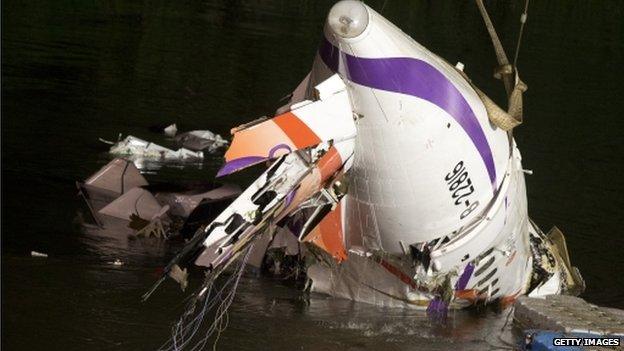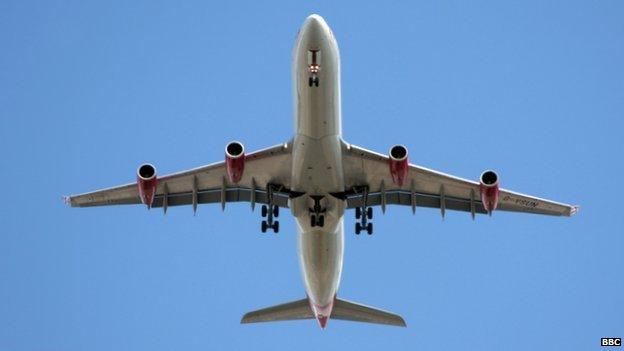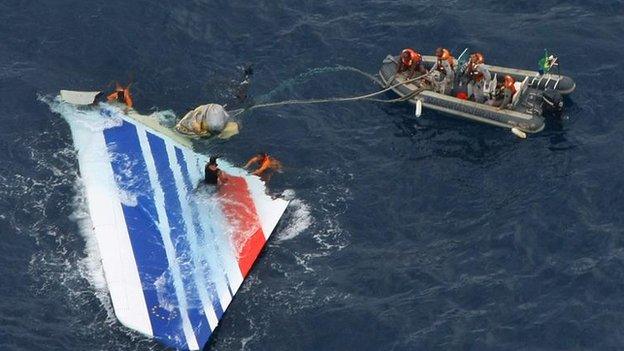Despite the headlines air travel is safer than ever
- Published

A TransAsia plane crashed into the Keelung river at New Taipei City
Yet again, we are looking at shocking pictures of a plane crash.
Yet again, you feel for the families of those killed on board, and the people that actually survived the ordeal.
It seems never ending. In less than a year two Malaysian aircraft have been lost, with 537 people on board.
The AirAsia accident - en route to Singapore in December - killed 162, external. It is not just the accidents. It's the fact that whole aircraft are going down without warning.
You would be forgiven for thinking that flying is becoming more lethal.
But you would be wrong.
In fact, when you look at the number of crashes and fatalities compared to the huge number of people flying today (3.2 billion passengers last year), we are in a golden era of aircraft safety.
According to safety analysts Ascend, 2014 was narrowly the safest year ever, with one fatal accident per 2.38 million flights, compared to every 1.91 million flights the year before.
It must be noted that that does not include the loss of the Malaysian airliner over Ukraine, where 298 people died, which they count as a war loss rather than an accident.
But even with that flight added it is not a terrible year, historically.
Another respected organisation, the Aviation Safety Network, registers 21 fatal accidents in 2014 (this time including Ukraine), compared to 29 in 2013 and 23 the year before that.

Despite recent events, we are in a golden era for airline safety
Nearly 1,000 people died in 2014, which is 700 more than the year before.
Horrible numbers, but compare that to the worst year, 1972, when 2,370 passengers were killed - and far fewer people were flying then, maybe a quarter of the number travelling today.
Technological advances
So why is flying getting safer? Well, technology.
"Think of your car in the 1970s", David Learmount, from Flightglobal tells me.
"The brakes, the handling, the lack of safety features. Well, aircraft are exactly the same.
"We knew most things about aerodynamics by the 1940s. What has changed is the technology."
Every new generation of aircraft has been safer than the one before. Better computers, design, materials.
But there is another sobering factor at play here too. Every tragedy has taught designers something new.
Go back a couple of decades and the biggest killer was something called Controlled Flight Into Terrain (CFIT).
A benign name with a morbid outcome, it normally involved a perfectly serviceable aircraft coming into land, then hitting something on the ground without the crew even knowing it was there.
Many airports are near hills.
Then along came a piece of equipment that was to transform safety: the Enhanced Ground Proximity Warning System.
"It's like a sat nav that can help you thread your way through hills and mountains, even in clouds", David says.
Learning lessons
Here is another example of how disaster has led to safer flying.
In 1985 a British Airtours aircraft was taking off from Manchester Airport, en route to Corfu.
The pilots aborted at the last minute because one of the engines failed, but the aircraft was also on fire, external.

There was nothing wrong with Air France A330 plane
Fifty-four people died fleeing the smoke, the aisles were jammed with passengers panicking to get out.
Next time you fly, look at the floor.
You will probably see strip lights along both sides of the aisle, then they turn and lead to each exit.
That idea comes straight from the Manchester fire. The lights mean passengers can find the exit, even crawling on their hands and knees through thick smoke.
"Our founder was actually working on emergency guide lights to help people escape from nuclear power stations and submarines," says Nigel Duncan, boss of STG aerospace.
"This accident made him realise they could be used in planes too".
Nigel's company now supplies guiding lights for the floors of 9,000 airliners. They are photoluminescent, "which means they are fail-safe".
"It's a chemical process so they don't need power - sever it and it still works," he says.
New risks
For the most part, computers fly modern airliners.
And they are very good at it. But all of this safety-driven automation has led to a new safety concern that is uncomfortable to hear.
Pilots don't get enough practice at actually flying planes. The computer has taken them out of the loop.
Six years ago, Air France flight 447, external crashed into the Atlantic, killing 228 people.
Yet there was nothing critically wrong with the plane.

Pilots now rely heavily on computer technology
So why did it crash? Well, the weather was bad and a small tube froze up, knocking out the speed indicator.
The actual speed was fine, but the speed data on their screens was all over the place.
Suddenly, the computer didn't know how fast it was going, and it handed control back to the pilots.
Confused, in bad weather, in darkness and taken by surprise, they couldn't work out what was happening, so they kept climbing to the point where the aircraft stalled, effectively stopping in mid-air and falling from the sky.
Unsurprisingly, plenty in the industry want more hands-on training for pilots.
"A few years ago the airlines used to get more crew from the military and those guys were used to manually flying aircraft right on the edge", David Learmount tells me.
"Today, many pilots don't have that kind of background training."
Having said all of that, just bear in mind:
Nothing is ever without risk, but the chances of dying in an aircraft "accident" are lower than ever.